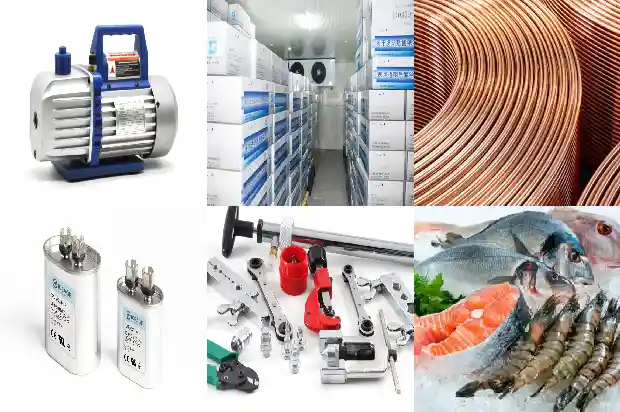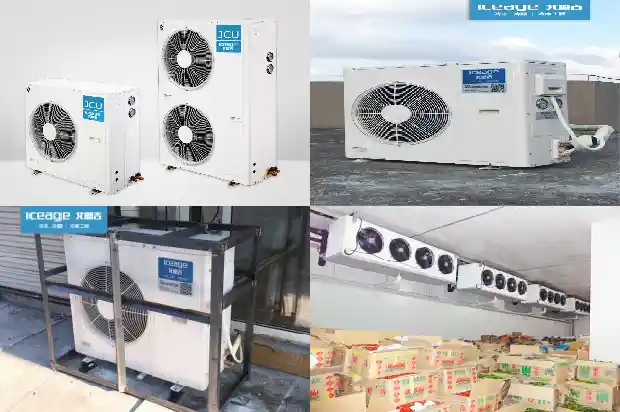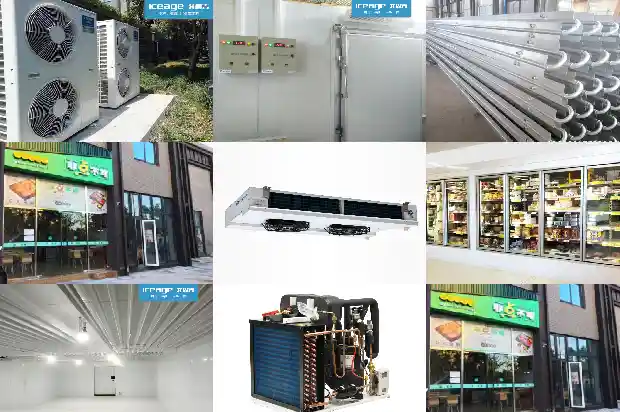Several Key Components on the Oil Circuit of the Refrigeration System
2025-03-05
In the refrigeration system, in order to ensure the normal operation of the refrigeration compressor, appropriate lubricating oil is used. At the same time, during the process of refrigerant transmission, part of the lubricating oil will be carried out of the compressor and enter the system. To avoid affecting the operation of the refrigeration system, it is necessary to control the carried-out oil. Therefore, in the refrigeration system, some components for "managing" the oil are installed, mainly including the oil separator, oil level controller, oil reservoir, oil filter, etc.
Oil Separator: It is a device that separates the lubricating oil from the refrigerant. It is installed between the exhaust end of the compressor and the condenser to separate the lubricating oil from the refrigerant vapor discharged from the compressor and return it to the oil reservoir or the compressor, preventing excessive lubricating oil from entering the condenser and the system.
A small amount of oil circulating in the system will not affect the system's performance. However, if too much oil enters the exhaust pipe and the system along with the refrigerant gas, it will have some negative impacts on the operation and performance of the system:
- Excessive oil will reduce the effective heat exchange of the system in heat exchangers such as the condenser and the evaporator.
- The accumulation of oil in components such as the expansion valve, solenoid valve, and control devices will lead to the malfunction or failure of these components.
- The oil accumulated in the pipeline may return to the compressor in large quantities due to the sudden acceleration of the refrigerant flow rate caused by changes in working conditions, resulting in "liquid hammer".
In addition, if there is no oil return or insufficient oil return, the reduction of lubricating oil in the compressor will cause compressor bearing failures or excessive wear of the internal moving parts of the compressor, leading to compressor damage. Especially in low-temperature or cryogenic equipment, oil return is crucial.
The function of the oil separator is to safely collect and return the oil to the compressor and reduce the migration of compressor lubricating oil into the refrigeration system. When the mixture of gas and oil enters the oil separator, its speed is slightly reduced, and the oil and gas are separated.
Generally, an oil separator with a 90% oil separation efficiency can ensure the normal and reliable operation of other components in the system on the basis of ensuring sufficient oil return to the compressor. A 95% centrifugal oil separator is mostly suitable for parallel units. It is necessary to select an appropriate oil separator according to the calculated required cooling capacity, and pay attention to the pre-filled oil quantity indicated by the manufacturer of the oil separator during use.

Commonly used oil separators are classified according to their working principles into filter type, packed type, centrifugal type, and scrubbing type, etc. Filter type or packed type are mostly used in Freon refrigeration devices, and centrifugal type is mostly used in screw or large compressors. The filter type oil separator mainly realizes the functions of oil separation and oil return through the filter screen and the automatic oil return float ball valve group. The centrifugal oil separator has guide vanes inside. When the refrigerant vapor enters the oil separator, under the action of centrifugal force along the guide vanes, the oil with a higher specific gravity is thrown to the inner wall of the container to achieve separation from the refrigerant.
The function of the oil level controller is to ensure the minimum oil level in the compressor crankcase. Structurally, it can be divided into mechanical float control (mechanical oil level controller) or electronic control (electronic oil level balancer).
The traditional oil level control system returns the oil at a pressure equal to or slightly higher than that of the system. A newer system design method returns the oil at the exhaust pressure, which is also called high-pressure oil return.

The electronic oil level controller is applied to conventional parallel compressor units, which can optimize the performance and service life of the units. Especially for protecting the parallel compressor units of commercial refrigeration systems under variable working conditions or mixed working conditions, electronic oil level controllers are mostly used. Fully enclosed or some semi-enclosed reciprocating compressors are equipped with their own oil pumps and may not require an oil level control system. However, for compressors without oil pumps, such as scroll compressors and some semi-enclosed reciprocating compressors, the protection method of oil level control should be adopted.

Working Principle of the Electronic Oil Level Controller:
- Measure the magnetic field generated by the sensor approaching the sensor magnet through the inverse Hall effect sensor.
- When the oil level drops by 1/8", the timing circuit is activated. If the oil level does not return to normal within 5 seconds, the oil return solenoid valve will be turned on to return the oil to the compressor.
- When the oil level reaches the set point, after a 5-second delay, the solenoid valve closes the circuit.
- If the oil level does not reach the set point within two minutes, the alarm relay will be activated.
The principle of the mechanical oil level controller is to control the oil level in the compressor crankcase through the opening and closing of the float ball, keeping the oil level in the normal position. It is also called mechanical oil balance or mechanical oil level switch.
A sight glass and a filter are also installed on the oil circuit: The sight glass, also known as the liquid level sight glass, is installed between the oil filter and the oil separator to indicate the oil level of the lubricating oil and the flow situation of the oil return. The main function of the oil filter is to ensure the cleanliness of the oil returning to the oil level controller. According to the difference in their filtration accuracy (the particle size of the impurities filtered out), there are four types of oil filters: coarse filter, ordinary filter, precision filter, and ultra-precision filter. They can respectively filter out impurities larger than 100μm, 10~100μm, 5~10μm, and 1~5μm in size. The replaceable filter element is made of single-layer or multi-layer metal mesh and filter media, intercepting various contaminants generated during operation and preventing them from entering the compressor. After the filter element is used for a period of time, its cleanliness will decrease, and in severe cases, the oil circuit will be blocked. It is necessary to clean or replace it regularly.
The oil reservoir is an oil storage device when the compressor does not need oil return temporarily, preventing oil from accumulating in the refrigeration pipeline. For example, in an ammonia refrigeration system, an oil drain valve or an oil collector will be installed at the lowest position where oil may accumulate.
In conclusion, by selecting appropriate oil circuit components, reasonably adjusting the flow rate of the refrigeration oil supplied to the compressor crankcase, and maintaining the oil level as low as possible according to the specified requirements of the compressor manufacturer, the normal operation of the compressor can be ensured.
Related Articles
- HVAC - Common Auxiliary Components of the Refrigeration System
- Analysis of the Main Functions and Components of Refrigeration Air Conditioners
- Analysis of Common Auxiliary Components in the Refrigeration System One by One
- Advantages and Disadvantages of Air-cooled Multi-connected Units and Analysis of Their Components
- Do You Have a Thorough Grasp of All 34 Components and Functions of the Air-Cooled Multi-Split System?
- Analysis of Common Auxiliary Components in the Refrigeration System
- Refrigeration Components of Refrigeration
- Principles, Components and Heat Recovery of Modular Units
- Basic Knowledge of Valve - type Components in Refrigeration Systems (Technical Sharing)
- Analysis of 6 Components in Air - cooled Multi - split Systems
- Analysis of Advantages, Disadvantages and 34 Common Components of Multi - split Air Conditioners
- Are you familiar with the detection and maintenance methods of air conditioner components?
- Top Ten Components of Refrigeration Systems and Five Common Troubleshooting!
- Refrigeration System Circulation and Components for Freezing and Cold Storage
- Principles of Refrigeration Systems and Functions of Components Explained
- Defrosting Operation Modes of Refrigeration Equipment and Its Control Components
- Refrigeration System Components and Common Failures
- Structural Components of Centrifugal Compressor
